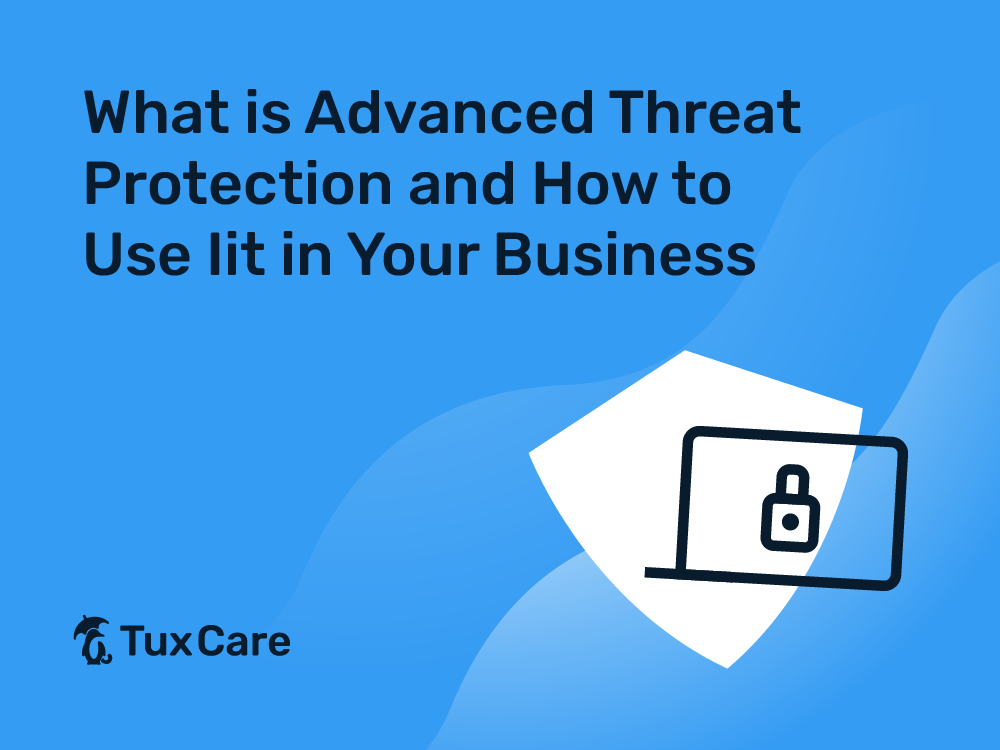What is Advanced Threat Protection and How to Use It in Your Business
As businesses accelerate their digital initiatives, the shadow of cybersecurity threats grows. Every advancement brings new challenges—is your Google account hacked? Are covert malware campaigns targeting your infrastructure? Amidst extensive data breaches, companies find themselves in a game of digital cat and mouse.
Today, traditional security measures such as firewalls and antivirus programs often fall short against modern threats. The need to stay a step ahead has never been more pressing, demanding an update from reactive strategies to proactive defense mechanisms.
Enter advanced threat protection (ATP). This innovative security solution proactively identifies, addresses, and neutralizes even the most elusive threats. In this article, we’ll explore ATP, explain its importance in modern business, and offer tips on how to add it to your organization.
What is advanced threat protection?

Advanced threat protection is a comprehensive shield that safeguards sensitive data from intricate cyber threats, including malware and phishing attacks. As digital risks evolve, ATP boosts your organization’s resilience, integrating cloud security, advanced email threat protection, and endpoint security.
Delving further into its capabilities, ATP incorporates in-depth threat analysis and specialized threat protection software. The upshot? A fortified framework adept at detecting potential security breaches before they amplify, ultimately working to bolster your enterprise software against cyber threats.
The need for ATP in today’s business environment
In today’s dynamic business landscape, cyber threats are a formidable force capable of halting a company’s momentum. Advanced threat protection stands out as a critical component in your cybersecurity toolbox.
- High cost of data breaches: A single breach can tarnish a company’s reputation, erode customer trust, and impact profitability, especially in areas like call center systems, where a breach could severely disrupt operations. ATP minimizes these risks, protecting customer data and your company’s integrity.
- Sophisticated cyberattacks: As cyber threats rapidly evolve, the increase in remote work has led to a surge in business email compromise (BEC) scams. By adapting in real time to emerging threats, ATP uses advanced algorithms and machine learning to quickly neutralize these attacks.
- Real-world impact: 2023 saw major disruptions in the business world due to advanced cyber threats, highlighted by the Rackspace Ransomware Attack and the cyberattack on Cisco. Companies faced data loss and financial hardships, underlining the urgency for implementing ATP solutions.
As we can see, ATP safeguards an organization’s data integrity, preserves its reputation, and ensures the smooth operation of services. It’s a proactive defense that businesses should utilize in order to thrive and stay secure.
Core features of advanced threat protection

Image sourced from statista.com
Behavioral analysis
Behavioral analysis in ATP involves scrutinizing regular user activities and identifying anomalies that might indicate a security threat. This process distinguishes between legitimate user actions and potentially malicious activities to ensure timely and accurate threat detection.
Threat intelligence
When a new threat emerges in different industries, ATP cybersecurity solutions swiftly integrate it into their monitoring systems to protect other organizations from potential harm. Rapidly sharing this knowledge is vital and guarantees first-rate security across various sectors.
Sandboxing
Sandboxing isolates potentially harmful files in a secure virtual environment, preventing them from compromising other server files. This approach contains the malware for analysis, safeguarding the host device. Following isolation, advanced threat detection scrutinizes the file’s behavior to identify potential security risks.
Email filtering
Email filtering in ATP examines incoming emails for phishing attempts and malicious attachments. By identifying and blocking these threats, the security tool helps protect organizations from one of the most common vectors of cyberattacks.
Cloud protection
With the increasing adoption of cloud services, cloud protection has become an indispensable feature of ATP. It secures the protection of cloud platforms and data, safeguarding against threats specific to cloud-based environments and, by extension, protecting cloud-hosted enterprise VoIP solutions.
Benefits of implementing advanced threat protection
Advanced threat protection provides a proactive defense against emerging cyber threats and actively identifies unusual behaviors that could signal a breach. This preemptive strategy provides swift identification and counteraction, securing your digital landscape and protecting data through live patching.
- Cloud analytics integration: ATP offers the advantage of cloud analytics integration, allowing you to gain valuable insights into your security and threat landscape. Using this, you can continually monitor and analyze security data to identify patterns and potential vulnerabilities.
- Visibility: ATP maintains visibility across various systems; it employs numerous threat detection techniques. This broader insight aids in monitoring network traffic and pinpointing potential threats. It enables the identification of affected parties, ranging from contractors to devices.

Image sourced from financesonline.com
- Streamlined incident response: ATP plays a crucial role in accelerating the incident response process. By providing detailed information on the nature and scope of the attack, ATP enables security teams to quickly understand and mitigate the impact, significantly reducing recovery time.
- Adaptability to new threats: Given the relentless evolution of sophisticated network attacks, malware detection requires continuous updates to address emerging threats. ATP ensures that an organization’s cybersecurity measures are consistently up to date and equipped to handle the latest challenges.
How to use advanced threat protection in your business
Implementing APT in your organization necessitates a strategic approach that allows you to safeguard your digital assets against sophisticated cyber threats. Here’s a guide to help you efficiently use ATP:
1) Assessment and planning
Begin by evaluating the existing level of protection in your business. Make sure to consider all aspects of your digital infrastructure, including specialized tools like small business telephone services, as these can be potential points of vulnerability.
Identifying potential weaknesses and areas that require enhancement establishes a robust foundation for ATP implementation. Use the insights gathered from this assessment to formulate a tailored strategy that addresses your unique needs and complexities.
Here are some guidelines to adopt with your team:
- Password management: Emphasize the importance of strong, unique passwords and encourage regular updates to prevent common security pitfalls.
- Device usage: Establish clear rules for using personal devices at work to ensure secure connections to the company network.
- Safe browsing: Define acceptable online behavior and website access during work hours, and balance productivity with freedom without compromising security.
- Incident response: Develop a swift action plan for cyberattacks to quickly isolate affected systems and minimize potential damage.
2) Choose the right ATP solution

Image sourced from databarracks.com
Your choice should revolve around factors such as business size, industry, and your existing IT infrastructure. Research and compare popular ATP vendors, taking note of their unique features and how they align with your requirements.
This step ensures that you invest in a solution that adequately meets your cybersecurity needs. Below are some of the factors you should take into account:
- Regulatory commitments: Ensure that the ATP solution complies with industry regulations and geographic legal requirements, whether it’s HIPAA, GDPR, or others. Integrating with your existing compliance technology avoids legal pitfalls.
- Scalability and future-proofing: With the escalating costs of cybersecurity, opt for an ATP solution that promises scalability and longevity. Leveraging artificial intelligence (AI) ensures your investment adds value over time.
- Identifying and filling security gaps: Conduct a thorough analysis of your current security setup to pinpoint specific data and storage vulnerabilities. As part of this process, incorporate a domain name search to identify potential risks associated with your online presence. Your ATP solution should address these gaps and fortify your defense against potential breaches.
- Simplicity and user-friendliness: Ease of deployment is paramount. Look for solutions that offer straightforward integration, possibly even without needing an agent. Onboarding new users should be seamless, accommodating various roles within your organization without creating unnecessary complexity.
3) Deployment and integration
Integrate the chosen ATP solution with your existing security infrastructure to guarantee compatibility across different platforms and devices.
Additionally, consider implementing different types of proxies, such as reverse proxies and forward proxies, to enhance your network security by adding an additional layer of protection between your internal network and external threats.
Proper configuration maximizes protection, setting up the ATP system to efficiently detect and respond to threats across all endpoints. This enhances your existing security measures without causing disruptions, thus providing a smooth integration experience.

Image sourced from malwarebytes.com
To further strengthen your cybersecurity stance, consider incorporating the following:
- AI and the cybersecurity landscape: Implement advanced AI algorithms to proactively seek out and neutralize potential threats before they can exploit vulnerabilities in your system.
- Next-generation antivirus with integrated firewall: Upgrade your defense mechanisms with a robust antivirus solution that works hand in hand with an integrated firewall; this ensures a double layer of protection against cyber threats.
- Mobile device management: Extend your ATP solution to include mobile device management so that all devices connected to your network, regardless of their type, are secure and compliant with your cybersecurity policies.
4) Continuous monitoring and updates
To further enhance your cybersecurity strategy, consider integrating a vulnerability monitoring service into your ATP solution. Ensure that your ATP solution receives regular updates to stay ahead. Actively monitor system logs and alerts to promptly identify security incidents. This ongoing vigilance maintains a resilient and robust cybersecurity stance and safeguards your business against multiple cyber threats.
By diligently following these steps, you can effectively use advanced threat protection to enhance your cybersecurity measures and establish a safer digital environment for your business operations.
Wrapping up
The digital landscape is fraught with challenges, but with ATP, businesses have a powerful tool at their disposal to safeguard their operations, protect their reputation, and ensure the security of their data.
By staying vigilant and proactive, and by embracing the advanced capabilities of ATP, you can navigate the digital realm with confidence and guarantee the long-term success and security of your organization.



 Documentation
Documentation Login
Login




